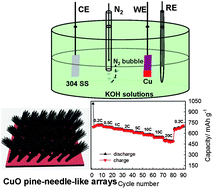Facile fabrication of CuO 1D pine-needle-like arrays for super-rate lithium storage†
Abstract
CuO one-dimensional (1D) pine-needle-like (PNL) arrays grown directly on a Cu substrate have been fabricated via an anodic polarization route. By controlling experimental conditions, CuO PNL arrays could be transformed into nanoneedle (NN) arrays and divergent pine needles (DPNs). Used directly as the integrated nanoarchitectured anodes of lithium-ion batteries (LIBs) with carbon-free and binder-free, CuO PNL arrays, NN arrays and DPNs all anodes exhibit excellent lithium storage properties. The sequence of rate capability is CuO PNL arrays > NN arrays > DPNs. CuO PNL arrays deliver the highest rate capacity of 545.9 and 492.2 mA h g−1 at 15 and 20C rates and exhibit excellent cyclability of 583.1 mA h g−1 after 100 cycles at 2C rate. The super-rate capability may be ascribed to the unique PNL array structures, which provide suitable nanoneedle branches for lithium storage and suitable free space to facilitate Li+ flux across the interface, as well as accommodating the large volume variation.


 Please wait while we load your content...
Please wait while we load your content...